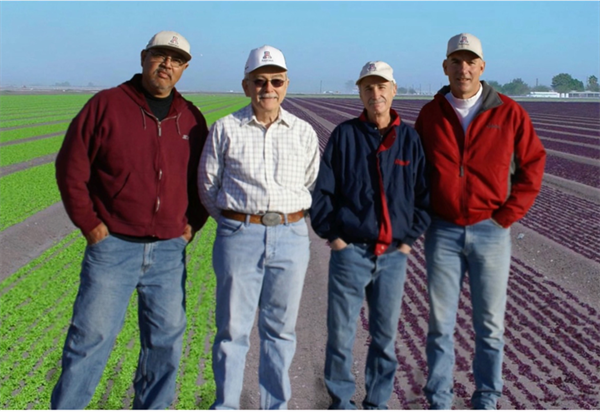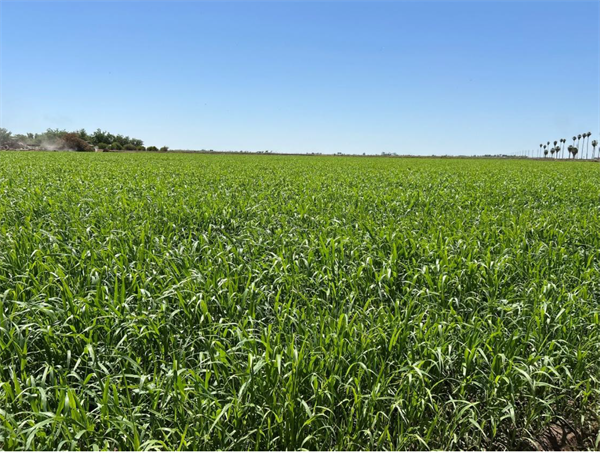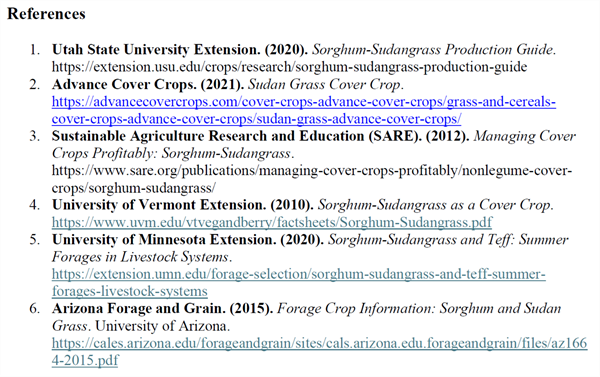
In several previous issues of this UA Vegetable IPM Newsletter (Silvertooth a,b, and c; 2025), I have presented a melon (Cucumismelo ‘reticulatus’ L.) crop phenology model (Figure 1; Silvertooth, 2025a) based on heat unit accumulations (86/55 ºF thresholds) and I have chronicled the development of the 2025 spring melon crop in the lower Colorado River areas at several stages of growth.
Referring to the data from AZMET for several locations in the Yuma area (Link to AZMET) , we can obtain the HU accumulations from 1 January 2025 for a set of four possible 2025 planting dates that are listed in Table 1. The HU accumulations from 1 January 2025 to 15 May 2025 for these sites are listed in Table 2.
The HU accumulations after planting (HUAP) for these four possible planting dates for three Yuma area locations to 15 May 2025 are shown in Table 3. The HUAP values in Table 3. These HUAP values are simply the difference between the values in Tables 1 and 2 between 15 May and the planting date.
As an example for the Yuma Valley, HU accumulations for the 15 January 2025 planting date from 1 January was 73 HU. The HU accumulation from 1 January to 15 May was 1419 HUs. Thus, the HUAP = 1419 – 73 = 1346 HUAP for this case.
The information in Table 3 can help serve as a reference to check for melon crop development in the field against this phenological model in Figure 1. Since the 2025 spring melon season has been relatively cool, based on long-term averages, some producers and field personnel have noticed a later maturity of the crop based on the calendar. However, the early planted crops were just ready to begin harvest in mid-May, which is consistent with the HU-based phenological model (Figure 1).
Some variation exists among fields with different melon types and varieties but this phenological model is tracking the general progress and development of the 2025 spring melon crop in the desert Southwest and this has been a good season to demonstrate this model.


Table 1. Heat unit accumulations (86/55 ºF thresholds) after 1 January 2025 on four
possible 2025 planting dates utilizing Arizona Meteorological Network (AZMET) data for
each representative site. †
†AZMET data for the Yuma Valley, Yuma North Gila Valley, and the Roll area of the Gila
River Valley can be accessed via the following link: Link to AZMET

Table 2. Heat unit accumulations (86/55 ºF thresholds) after 1 January 2025 to 15 May
2025 utilizing Arizona Meteorological Network (AZMET) data for each representative site.

Table 3. Heat unit accumulations (86/55 ºF thresholds) after planting (HUAP) from four
possible 2025 planting dates and three sites in the Yuma area on 15 May 2025 utilizing
Arizona Meteorological Network (AZMET) data for each representative site. Each value
is rounded to the next whole number. Note: the values in Table 3 are determined by
taking the difference between the HUs for each representative site and four planting
dates from corresponding values in Tables 1 and 2.

Figure 1. Melon (cantaloupe) phenological development model expressed in Heat Units
Accumulated After Planting (HUAP, 86/55ºF).
Frost and freeze damage affect countless fruit and vegetable growers leading to yield losses and occasionally the loss of the entire crop. Frost damage occurs when the temperature briefly dips below freezing (32°F).With a frost, the water within plant tissue may or may not actually freeze, depending on other conditions. A frost becomes a freeze event when ice forms within and between the cell walls of plant tissue. When this occurs, water expands and can burst cell walls. Symptoms of frost damage on vegetables include brown or blackening of plant tissues, dropping of leaves and flowers, translucent limp leaves, and cracking of the fruit. Symptoms are usually vegetable specific and vary depending on the hardiness of the crop and lowest temperature reached. A lot of times frost injury is followed by secondary infection by bacteria or opportunist fungi confusing with plant disease.
Most susceptible to frost and freezing injury: Asparagus, snap beans, Cucumbers, eggplant, lemons, lettuce, limes, okra, peppers, sweet potato
Moderately susceptible to frost and freezing injury: Broccoli, Carrots, Cauliflower, Celery, Grapefruit, Grapes, Oranges, Parsley, Radish, Spinach, Squash
Least susceptible to frost and freezing injury: Brussels sprouts, Cabbage, Dates, Kale, Kohlrabi, Parsnips, Turnips, Beets
More information:
For those interested in in-row weed control, checkout the quality video below (Fig. 1) on how finger weeders (Fig. 2) are being used on a 3,600 acre organic cotton farm in Texas. The grower states that finger weeders help him achieve 95-97% weed control and are a highly cost-effective tool for lowering hand weeding costs.
Fig. 1. Carl Pepper discusses how finger weeders are used to control in-row weeds on
his 3,600 acre organic cotton farm. Click here or on image to view. (Photo credit: Tilmor
LLC, Dalton, OH)

Fig. 2. Finger weeders, an in-row weeding tool, operating in seedling cotton. Finger
weeder pairs are centered on the seed row and overlapped slightly to loosen soil in the
row and uproot small weeds.
In 2010 we started publishing the Arizona Vegetable IPM Updates to a small number of friends. It was embraced by the community because of contributions from Mike Matheron, John Palumbo and Barry Tickes in the Plant Pathology, Entomology and Weed Science areas. Mike, John and Barry are the original IPM dudes.

I was honored to be part of the team editing and sending the Newsletter for almost
16 years.

This is my last update, and I would like to thank the UA team and the agricultural community for the opportunity to work with you.
Biological control is an important IPM tool globally. This pest suppression technique is especially important for managing pests in organic crop production. There are various biological control techniques, including conservation biological control, classical biological control, and augmentative biological control. Conservation biological control is the practice of providing habitat to support abundant populations of naturally occurring arthropods that attack crop pests. However, classical biological control and augmentative biological control involve the release of arthropod predators and parasitoids, usually non-native, into the field or greenhouses. This article focuses on conservation biological control.
The contribution of native beneficial insects to pest control has been estimated to be approximately $4.5 billion annually in the United States alone. However, the benefits of beneficial insects areoften overlooked. Research conducted across the country has shown evidence that conserving natural habitats leads to an increase in beneficial arthropod populations and a reduction in pest problems on farms. Beneficial arthropod predators and parasitoids often rely on natural or semi-natural areas adjacent to the field for their persistence. Between growing seasons, these natural and semi-natural areas provide alternative food sources, overwintering, and nesting habitats for natural enemies, thereby promoting their populations. To complete their life cycle, natural enemies require more than just prey or hosts; they also need refuge sites and alternative food sources.
Neighboring natural and semi-natural habitats serve as sources of natural enemies during the growing seasons to suppress crop pests. The establishment of wildflower margins around crop fields increases the abundance of beneficial insects that search for pollen and nectar. For example, many adult parasitoids sustain themselves with pollen and nectar from nearby flowering plants while searching for hosts. Most natural enemies do not disperse far from their overwintering sites; access to permanent habitat near or within the field gives them a jump-start on early pest populations.
Farms with diverse and dense populations of natural enemies are likely to exhibit the following characteristics:
- Have small fields surrounded by natural vegetation.
- Composed of diversified cropping systems and plant populations in or around fields include perennials and flowering plants.
- Crops are managed organically or with minimal agrichemicals.
- Soils are high in organic matter and biological activity and, during the off-season, covered with mulch or vegetation.

Figure 1. Syrphid fly feeding from sweet alyssum flowers.

Figure 2. Mix flowers planted on strips between rows of celery to provide food and
shelter for natural enemies.
In the arid farming systems of Yuma, Arizona, growers often face the challenge of sustaining soil health and productivity between intensive winter vegetable cropping seasons. One effective, science-backed strategy to support this transition period is the use of Sudan grass (Sorghum Sudanese) as a summer cover crop (Figure 1).
Sudan grass grows rapidly in hot, dry conditions, making it well-suited for our desert climate. Its value extends beyond simple ground cover; this warm-season annual plays a pivotal role in enhancing long-term soil health, improving field conditions, and supporting environmental resilience.

Figure 1. Sudan grass in the Valley Research Center at the University of Arizona, Yuma
Agricultural Center, Yuma, Arizona.
Soil Health Benefits
Sudan grass contributes significant organic biomass, which boosts soil organic matter and fuels microbial life (USU Extension, 2020). Its deep root system also improves soil structure by loosening compacted layers and enhancing water infiltration (Advance Cover Crops, 2021).
Natural Weed and Disease Suppression
Its dense canopy shades out summer weeds, while allelopathic compounds such as sorgoleone help suppress soil-borne pathogens (SARE, 2012). As a rotation crop, Sudan grass disrupts pest and disease cycles common in lettuce systems, including Fusarium wilt (UVM Extension, 2010).
Environmental and Water Efficiency
As a living cover, Sudan grass reduces dust, protects against erosion during monsoon events, and uses water efficiently compared to cash crops (Arizona Forage and Grain, 2015).
Economics and Future Crop Performance
Though not a direct income generator, Sudan grass has low input requirements and can be used as forage if needed (UMN Extension, 2020). Importantly, it leaves behind a biologically enriched soil bed that benefits subsequent crops like lettuce, often resulting in better stands and vigor (USU Extension, 2020)
Bottom Line
Sudan grass offers growers in the desert Southwest a strategic tool to enhance their production systems while supporting sustainability. By bridging the gap between seasonal crops, it transforms summer downtime into an investment in soil productivity and environmental stewardship.

Results of pheromone and sticky trap catches can be viewed here.
Corn earworm: CEW moth counts remain at low levels in all areas, well below average for this time of year.
Beet armyworm: Trap increased areawide; above average compared to previous years.
Cabbage looper: Cabbage looper counts decreased in all areas; below average for this time of season.
Diamondback moth: DBM moth counts decreased in most areas. About average for this time of the year.
Whitefly: Adult movement beginning at low levels, average for early spring.
Thrips: Thrips adult counts reached their peak for the season. Above average compared with previous years.
Aphids: Aphid movement decreased in all areas; below average for late-March.
Leafminers: Adults remain low in most locations, below average for March.